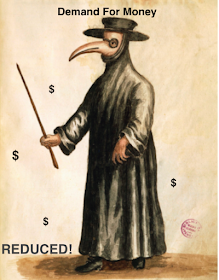(A) Draw a CLG of the money market and show the effect of the reduced holdings of money on the equilibrium nominal interest rate in the short-run.
Money Market = Monetary Policy
Reduced holdings of money = Demand for Money decreases
From the Monetary Policy cheat sheet here
 |
| Demand for Money falls, the Nominal Interest Rate (NIR) falls The opportunity cost of holding cash has fallen. |
(B) Based on the changes in the interest rate in part (A), what will happen to each of the following in the short-run?
(i) Prices of previously issued Bonds. ((Bond Prices will Increase)
MR. Waugh - If interest rates are falling then we must assume that the interest rates of previous bonds must be higher.
Jung Sub - What does that mean, Mr. Waugh?
Mr. Waugh - Well Jung Sub, each bond has an amount of interest that it pays to the owner of the bond every year. It could pay 5% of the face value to the owner every year. Bond holders are rational people. If the banks are only paying 1% to borrow your money a bond holder would be making a profit by having a bond paying 5%.
So, if the nominal interest rate falls to 1%, then the price of a bond paying 5% will increase as it is now a better value than bonds created and sold today with a yield rate of 1%.
Is that clear Jung Sub?
Jung Sub - Not really Mr. Waugh, but I think we should move on.
 |
| Jung Sub's face when I start talking about Bonds. |
(ii) The price level and real income.
Cause and effect - If the nominal interest rate falls then consumption increases which drives up AD and therefore the PL and causes the RGDP to increase which implies that real income (Y) increases also.
Answer - PL and Y (incomes) increase
Answer
(C) With a constant money supply, based on your answer in part (B)(ii), will the velocity of money increase, decrease, remain unchanged or will it be indeterminate?
Velocity of money is the rate that money exchanges for goods and services. If incomes are increasing we would expect that the velocity of money would increase.
AD is increasing along with RGDP and (Y) incomes so people are spending money faster than before. Velocity has increased.
Answer
(D) If the FED (central bank) wishes to reverse the changes in the interest rate identified in part (A), what open market operation (OMO) would it use?
If interest rates are falling (part A), then the FED would sell bonds, reducing the money supply and increasing the Nominal Interest Rate.
Answer







Hi William, for Q2.b(ii) if the nominal interest rate falls then AD will shift right. The price level will rise but wouldn't real incomes stay the same? We learn that real incomes are not affected by inflation because as prices rise so do wages. In theory at least changes in prices should be matched by changes in wages meaning no real change to incomes. I really like your blog by the way.
ReplyDeleteHello Bill, I agree that as the NIR falls AD will shift to the right, the Price Level increases as well as the RGDP. A Real GDP increase = (Y) aggregate income increases as more people are put back to work. I think we can see this as true if we are speaking as more people having jobs and total numbers of workers is increasing. But, if Joe has a fixed income and the price level rises wouldn't we say that Joe's real wage rate decreased. His purchasing power is reduced as the price level increases.. This was a very tricky question as most of the time the college board is asking about wage rates not aggregate incomes... Why would we necessarily assumes that any increase in price level will get an equal increase in wages? Thanks for the comment. :)
ReplyDeletewhy the naked man booty? loll
ReplyDeletebut in all seriousness this explanation really helped! thank you so much
ReplyDeletecheers,
DeleteCharles